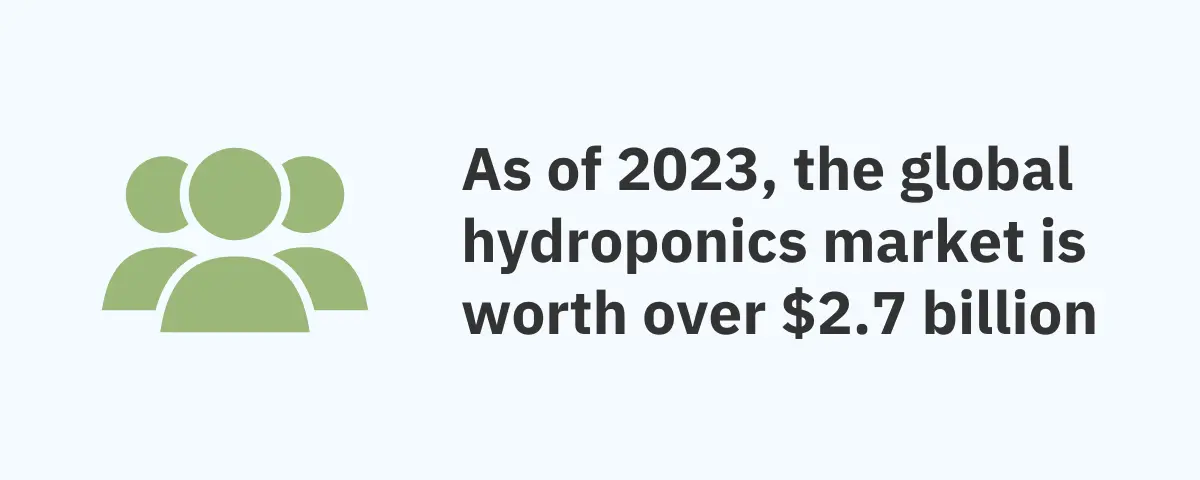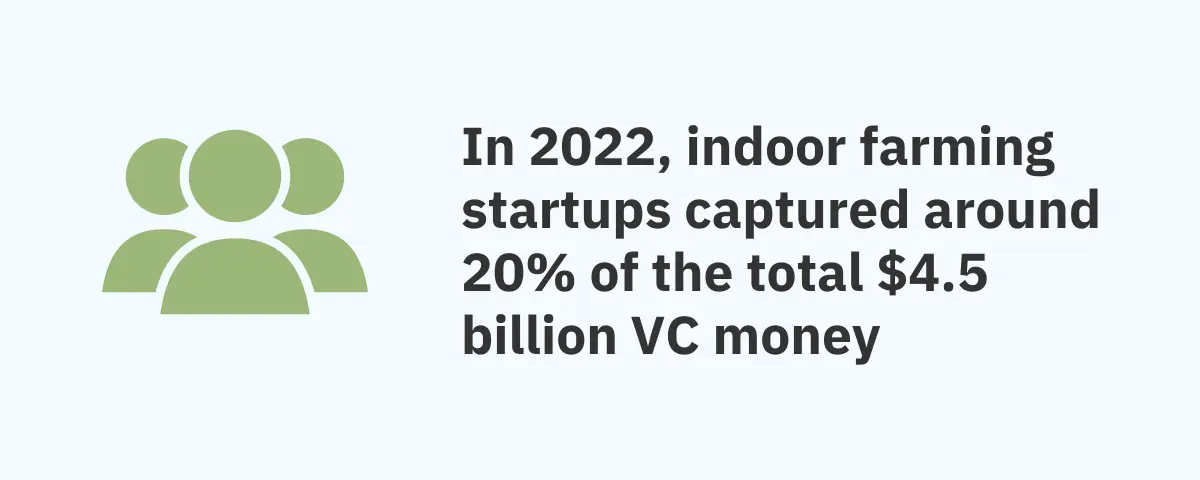Hydroponics Market Size, Growth, and Statistics (2023-2028)

Hydroponics is experiencing steady growth.

Hydroponics has many benefits over traditional agriculture, and its popularity and adoption rate is growing.
In fact, Hydroponic crops can be certified as organic in many places, including in the United States (source).
This report will take a closer look at the following Hydroponics trends and statistics:
- Hydroponics Industry Highlights
- Hydroponics Market Size
- Hydroponics Market Growth Projections
- Hydroponics Adoption Statistics
- Hydroponics Funding Statistics
- Key Players In The Hydroponics Market
- Hydroponics Market Segments
Hydroponics Industry Highlights
Hydroponics Market Size
As of 2023, the global hydroponics market is worth over $2.7 billion.

Factors contributing to the growth of the hydroponics market include an increase in global demand for food, higher yield than conventional farming, independence of external climatic conditions, and a rise in desertification around the world.
The country that owns the most market share in the hydroponics market is Asia Pacific, with China, Australia, South Korea, and other such countries leading the way with around 37% market share in 2020.

North America also dominates the market due to favorable government initiatives, technological advancements, and the presence of major hydroponic companies.
Europe is also a significant market, owing to rising consumer demand for locally grown produce and environmentally friendly farming practices.
Sources: GlobeNews Wire, Emergen Research, Sperical Insights, Grand View Research
Hydroponics Market Growth Projections
The Hydroponics market is estimated to reach $9.76 billion by 2028.

The market is expected to grow at a compound annual growth rate (CAGR) of 20.7% from 2021 to 2028.
Sources: Grand View Research
Hydroponics Adoption Statistics
From 2016 to 2022, the Hydroponics market witnessed a notable upswing, with a discernible increase in the adoption of hydroponic farming techniques and equipment.
Vegetables are the largest application segment in hydroponics. Lettuce and tomatoes are among the most commonly grown veggies using hydroponic methods.

Greenhouse farming accounts for the biggest share of hydroponics currently, but growth is high in other segments like vertical farming, aquaponics, aeroponics, and nutrient film technique (NFT).
Hydroponics is widely adopted by commercial growers of vegetables, fruits, and flowers. In fact, hydroponics is used to produce a significant amount of tomatoes and lettuce sold in the United States.
Hydroponics is also becoming increasingly popular among hobbyists who want to grow their own food or flowers indoors.
Hydroponics is ideal for urban farming because it can be used to grow crops in small spaces, such as rooftops and balconies.
Sources: Oklahoma State University, Future Market Insights
Hydroponics Funding Statistics
In 2022, indoor farming startups alone captured around 20% of the total $4.5 billion venture investors plowed into agtech startups across 34 deals.

For example, Little Leaf Farms, a brand of packaged lettuce grown through controlled environment agriculture, has raised $300 million in new capital.
Main areas receiving investment and funding for hydroponics include:
- research
- commercial farming operations
- and consumer/home systems.
Government funding sources include USDA grants for specialty crop research, which has included hydroponic projects.
Sources: Crunchbase, Food Business News, USDA
Key Players In The Hydroponics Market
Sources: Mordor Intelligence, Future Market Insights
Hydroponics Market Segments
The Hydroponics Market is divided into different segments based on type, crop type, equipment, input, farming method, crop area, etc.
Here are the different segments covered in the Hydroponics Market:
By Type
- Aggregate systems
- Ebb & flow systems
- Drip systems
- Wick systems
- Liquid systems
- Deep water culture
- Nutrient film technique (NFT)
- Aeroponics
By Equipment
- HVAC
- LED grow lights
- Control systems
- Irrigation systems
- Material handling equipment
- Other equipment
By Input
- Nutrients
- NPK
- Trace minerals
- Other nutrients
- Grow media
- Rockwool
- Perlite & vermiculite
- Coco fiber
- Other grow media
By Crop type
- Vegetables
- Tomatoes
- Leafy greens
- Cucumbers
- Peppers
- Other vegetables
- Fruits
- Flowers
- Other crop types
By Farming method
- Indoor
- Outdoor
By Crop area
- Up to 1000 square feet
- 1000-10000 square feet
- 10000-50000 square feet
- Above 50000 square feet
Sources: MarketsandMarkets
Conclusion
The numbers speak for themselves—hydroponics is on a steep growth trajectory.
As investment and research in hydroponics expand, we will continue to see exciting innovations emerge.
Hydroponic systems already use new technologies like AI, robotics, and LED lighting to improve outputs.
Not to forget improved techniques like aquaponics and aeroponics that make hydroponics even more productive and eco-friendly.